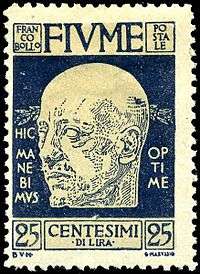Italian Regency of Carnaro
| Italian Regency of Carnaro | ||||||||||
| Reggenza Italiana del Carnaro | ||||||||||
| Unrecognized entity seeking unification with Italy | ||||||||||
| ||||||||||
|
| ||||||||||
| Capital | Fiume | |||||||||
| Languages | Italian | |||||||||
| Government | Provisional authoritarian republic | |||||||||
| Duce | Gabriele D'Annunzio | |||||||||
| Legislature | Arengo del Carnaro | |||||||||
| • | Upper house | Consiglio degli Ottimi | ||||||||
| • | Lower house | Consiglio dei Provvisori | ||||||||
| Historical era | Interwar period | |||||||||
| • | Coup d'état | September 12, 1919 | ||||||||
| • | Constitution | 8 September 1920 | ||||||||
| • | Treaty of Rapallo | 12 November 1920 | ||||||||
| • | Conquered | 30 December 1920 | ||||||||
| ||||||||||
The Italian Regency of Carnaro (Italian: Reggenza Italiana del Carnaro) was a self-proclaimed state in the city of Fiume (now Rijeka, Croatia) led by Gabriele d'Annunzio between 1919 and 1920. It is also known by its lyrical name Fiume Endevour (Italian: Impresa di Fiume).
Impresa di Fiume

During World War I (1914–1918), Italy made a pact with the Allies, the Treaty of London (1915), in which it was promised all of the Austrian Littoral, but not the city of Fiume. After the war, at the Paris Peace Conference, 1919, this delineation of territory was confirmed, with Fiume remaining outside of Italian borders, instead joined with adjacent Croatian territories into the Kingdom of Serbs, Croats and Slovenes.
Gabriele D'Annunzio was angered by what he considered to be handing over of the city of Fiume. On September 12, 1919, he led around 2,600 troops from the Royal Italian Army (the Granatieri di Sardegna), Italian nationalists and irredentists, into a seizure of the city, forcing the withdrawal of the inter-Allied (American, British and French) occupying forces. Their march from Ronchi dei Legionari to Fiume became known as the Impresa di Fiume ("Fiume Exploit").
On the same day, D'Annunzio announced that he had annexed the territory to the Kingdom of Italy. He was enthusiastically welcomed by the Italian population of Fiume.[1] This move was opposed by the Italian government and D'Annunzio tried to resist pressure from Italy. The plotters sought to have Italy annex Fiume, but were denied. Instead, Italy initiated a blockade of Fiume while demanding that the plotters surrender. During his time in Fiume in September 1919, Filippo Tommaso Marinetti called the leaders of the Exploit "advance-guard deserters" (disertori in avanti).
Regency
On September 8, 1920, D'Annunzio proclaimed the city to be under the Italian Regency of Carnaro with a constitution foreshadowing much of the later Italian Fascist system, with himself as dictator, with the title of Duce.
The name Carnaro was taken from the Golfo del Carnaro (Kvarner Gulf), where the city is located. It was temporarily expanded by D'Annunzio in order to include the island of Veglia. The only other State to recognize the Italian Regency of Carnaro was the Soviet Union.
Constitution

The Charter of Carnaro (Carta del Carnaro) was a constitution that combined anarchist, proto-fascist and democratic republican ideas. D'Annunzio is often seen as a precursor of the ideals and techniques of Italian fascism. His own explicit political ideals emerged in Fiume when he coauthored with syndicalist Alceste De Ambris, the leader of a group of Italian seamen who had mutinied and then given their vessel to the service of D'Annunzio. De Ambris provided the legal and political framework, to which D'Annunzio added his skills as a poet.
The constitution established a corporatist state, with nine corporations to represent the different sectors of the economy, where membership was mandatory, plus a tenth corporation devised by D'Annunzio, to represent the superior individuals.
The legislative power vested in a bicameral legislature consisting of a Council of the Optimates (Consiglio degli Ottimi) and a Council of Corporations (Consiglio dei Provvisori). Joint sessions of the Councils (Arengo del Carnaro), would be responsible for treaties with foreign powers, amendments to the constitution, and appointment of a dictator in times of emergency. The charter designated "music" to be one of the fundamental principles of the Fiume State.
Demise

The approval of the Treaty of Rapallo on 12 November 1920 turned Fiume into an independent state, the Free State of Fiume.
D'Annunzio ignored the Treaty of Rapallo and declared war on Italy itself. On 24 December 1920 the Italian army and a bombardment by the Royal Italian Navy forced the Fiuman legionnaires to evacuate and surrender the city.
The Free State of Fiume would officially last until 1924, when Fiume was eventually annexed to the Kingdom of Italy under the terms of the Treaty of Rome, 1924. The administrative division was called the Province of Carnaro.
See also
Notes
External links
| Wikisource has original text related to this article: |
- http://www.reakt.org/fiume/index_2.html
- Richard Doody. "STATI LIBERO di FIUME - FREE STATE of FIUME". Archived from the original on 22 December 2012.
- http://www.crwflags.com/fotw/flags/hr-fiume.html
